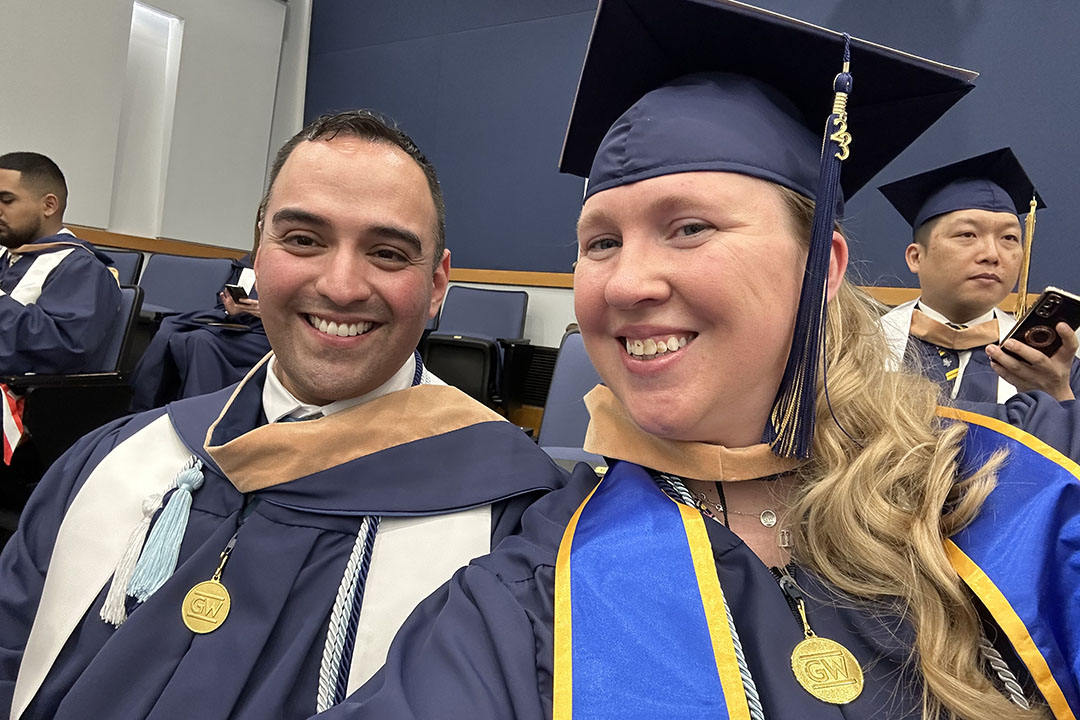There is no single profile for a graduate student at the George Washington University School of Business (GWSB). Some are continuing their studies straight after a bachelor’s degree. Others are mid-career professionals upgrading their skills. Still others are people pivoting to new professions.
Tucked among them—and broadening enrollment diversity—are students who are military veterans, active duty servicemembers and their family members.
GW has one of the largest military-affiliated enrollments among the nation’s private research universities, according to Andrew Sonn, director of the Office of Military and Veterans Students Services. For the fall 2023 semester, GW enrolled more than 1,400 military-affiliated students, about 10 percent of whom are pursuing degrees in GWSB.
Guadalupe Vega, M.S. ‘23, said one reason he enrolled at GW was its location in the nation’s capital. Another was the university’s active alumni network. But it was an Army commander’s praise of the university that sealed the deal.
“I remember that he talked about taking GW classes and what he said about it stuck with me,” Vega said. “This was the only graduate program that I applied to. It fit with my values and with what I was looking for in my education.”
In Vega’s very first class at GW, he ended up sitting next to Rebecca Strang, M.S. ‘23, who then was also pursuing a Master of Science in Human Resources. They quickly discovered that she, too, was military affiliated. Strang’s husband, now a lawyer at the U.S. Department of Justice, served more than eight years in the Army, and she studied at GW under his G.I. Bill benefits.
“When you talk with someone, you’re always trying to find those common bonds. Knowing that he was active duty, I could understand his situation because my family has been there,” Strang said. “We hit it off, and here we are, two years later, and we’re still in touch.”
Later in the year, Strang was randomly paired with another classmate on a project only to discover that he, too, had military affiliation.
Strang had long thought about getting a master’s degree to launch her career but as a military spouse with children, it was difficult. She has an undergraduate degree in sociology from the University of North Carolina.
“I was thinking about what a transferable job in the D.C. area would be, but also one that works anywhere,” Strang explained. “I knew I could also use my sociology background in human resources. Human resources was a good option.”
She currently works in human resources for a government contractor.
Vega, meanwhile, had served eight years in the Army and was on active duty at Fort Drum in New York when he applied to GW. The military gave him time off with pay while he pursued his studies full time. He now works as a human resources officer at Fort Irwin National Training Center in California—a big change from being a tank commander, which was his role when he first joined the military.
Vegas said GW’s leadership training has been especially valuable to him. He would eventually like to transition to the civilian sector, working in human resources, while remaining in the Army Reserves.
Both Vega and Strang said it was interesting to share with classmates the different lens through which the military addresses career promotion and other human resources strategies.
“In the military, for example, there is a limit on how many people get promoted. And in the military, you can’t bring someone in at a top post—as a general—with no experience in the military. But in the business world, you can [hire] someone who wasn’t a CEO before and bring them in,” Strang explained. “I benefited from getting the perspective that this is how some companies do it, and this is how the military does it.”
Vega, meanwhile, said in-class discussions revealed that students were unaware of how innovation is valued by the military, including in establishing a fair system for advancement.
The Million Records Project, a research study launched a decade ago by Student Veterans of America in partnership with the U.S. Department of Veterans Affairs, found that diverse perspectives were one of the most distinctive contributions of military students in the classroom. Military students, for example, are likely to have participated in multicultural training or have been stationed or deployed outside the country, giving them firsthand experiences with other cultures.
The military also trains its members to be problem solvers, to think under pressure and to be mission driven. “I wrote several papers for leadership classes at GW that focused on the military,” Strang said.
Military-affiliated students at GW are not obligated to reveal their background to professors or classmates, but Vega and Strang both described the classroom culture as welcoming. That dovetails with the university’s reputation as an institution committed to military student success. GW puts no cap on the number of Yellow Ribbon students it enrolls each year, it has a Military Community Center, and it is among only 100 schools where U.S. Department of Veterans Affairs (VA) staff directly counsel students on their educational benefits through the VA’s Vet Success on Campus program.
Vega also noted that professors offered extensions on assignments when military service disrupted students’ schedules. And he discovered that some professors had past military experience.
“I appreciate that the support is there. You have the Veteran Services Office, you have a lounge, you have recognition for Veterans Day and activities for veterans,” Vega said. “The engagement that GW provides for the veterans is fantastic.”



